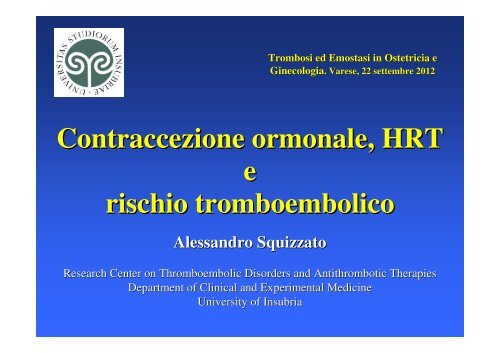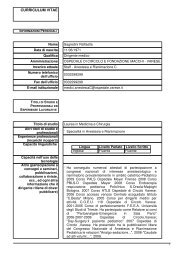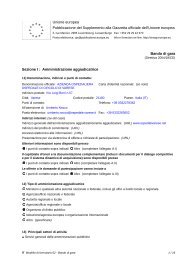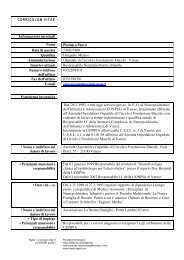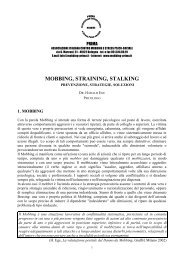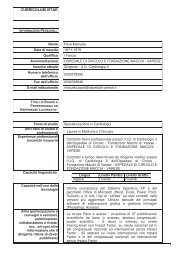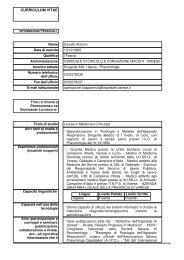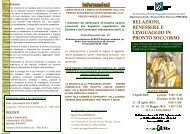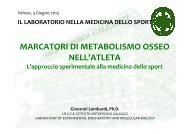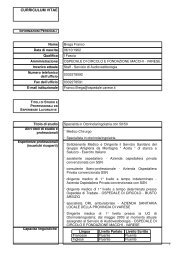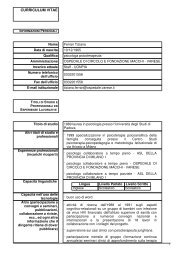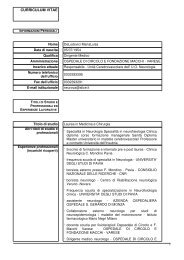Contraccezione ormonale, HRT e rischio tromboembolico
Contraccezione ormonale, HRT e rischio tromboembolico
Contraccezione ormonale, HRT e rischio tromboembolico
Create successful ePaper yourself
Turn your PDF publications into a flip-book with our unique Google optimized e-Paper software.
<strong>Contraccezione</strong> <strong>ormonale</strong>, <strong>HRT</strong><br />
e<br />
<strong>rischio</strong> <strong>tromboembolico</strong><br />
Alessandro Squizzato<br />
Trombosi ed Emostasi in Ostetricia e<br />
Ginecologia. Ginecologia.<br />
Varese, 22 settembre 2012<br />
Research Center on Thromboembolic Disorders and Antithrombotic Therapies Therapies<br />
Department of Clinical and Experimental Medicine<br />
University of Insubria
La COC e’ e un fattore di <strong>rischio</strong> per TEV?<br />
E la non COC ?<br />
E la terapia <strong>ormonale</strong> sostitutiva?<br />
Se si, è un fattore di <strong>rischio</strong> minore o maggiore?<br />
E’ utile lo screening trombofilico a tutte le donne?<br />
E’ anche un fattore di <strong>rischio</strong> cardiocerebrovascolare?
La COC e’ e un fattore di <strong>rischio</strong> per TEV?<br />
E la non COC ?<br />
E la terapia <strong>ormonale</strong> sostitutiva?<br />
Se si, è un fattore di <strong>rischio</strong> minore o maggiore?<br />
E’ utile lo screening trombofilico a tutte le donne?<br />
E’ anche un fattore di <strong>rischio</strong> cardiocerebrovascolare?
Embolia polmonare in una giovane donna che<br />
ha da poco iniziato 100 µg g di mestranol per<br />
l’endometriosi<br />
endometriosi<br />
Jordan WM. Lancet 1961;2:1146-7<br />
1961;2:1146
Vandenbroucke et al. NEJM 2003;344
COAGULAZIONE<br />
COC ed EMOSTASI<br />
Aumenta: F VII, X, XII, XIII,<br />
Riduce: Proteina S, antitrombina<br />
Resistenza alla proteina C attivata<br />
FIBRINOLISI<br />
Aumenta: Plasminogeno,<br />
Riduce: PAI-1<br />
Rosendaal et al. ATVB 2002;22
Farley et al. J Epidemiol Community Health 1998; 52
TEV e COC<br />
revisione sistematica 46 studi<br />
1. COC aumenta aumenta<br />
di 3-6 3 6 volte il <strong>rischio</strong><br />
2. alte dosi etinilestradiolo (>50 µg) g)<br />
raddoppiano il <strong>rischio</strong><br />
3. il <strong>rischio</strong> è maggiore nei primi 6-12 6 12 mesi. E’ E<br />
evidente dal 4 mese. Scompare dopo 3 mesi di<br />
sospensione<br />
4. i progestinici di 3 generazione sono a maggior<br />
<strong>rischio</strong><br />
Gomes et al. Arch Intern Med 2004;164
Farley et al.<br />
Contraception 1998;57
RISCHIO TEV<br />
3 a gen. vs 2 a gen.<br />
OR 1.7 (1.4-2.0)<br />
Kemmeren et al. BMJ 2001; 323
La COC e’ e un fattore di <strong>rischio</strong> per TEV?<br />
E la non COC ?<br />
E la terapia <strong>ormonale</strong> sostitutiva?<br />
Se si, è un fattore di <strong>rischio</strong> minore o maggiore?<br />
E’ utile lo screening trombofilico a tutte le donne?<br />
E’ anche un fattore di <strong>rischio</strong> cardiocerebrovascolare?
Non-COC Non COC e TEV<br />
9.429.128 donne/anno di osservazione in Danimarca (2001-2010)<br />
(2001 2010)<br />
Type RR 95% CI<br />
Transdermal patch 7.9 3.5-17.7<br />
Vaginal ring 6.5 4.7-8.9<br />
Subcutaneous<br />
implants<br />
1.4 0.6-3.4<br />
Lidegaard. BMJ 2012;22
La COC e’ e un fattore di <strong>rischio</strong> per TEV?<br />
E la non COC ?<br />
E la terapia <strong>ormonale</strong> sostitutiva?<br />
Se si, è un fattore di <strong>rischio</strong> minore o maggiore?<br />
E’ utile lo screening trombofilico a tutte le donne?<br />
E’ anche un fattore di <strong>rischio</strong> cardiocerebrovascolare?
WHI Investigators. NEJM 2003; 349
La COC e’ e un fattore di <strong>rischio</strong> per TEV?<br />
E la non COC ?<br />
E la terapia <strong>ormonale</strong> sostitutiva?<br />
Se si, è un fattore di <strong>rischio</strong> minore o maggiore?<br />
E’ utile lo screening trombofilico a tutte le donne?<br />
E’ anche un fattore di <strong>rischio</strong> cardiocerebrovascolare?
Geerts et al. Chest 2004; 126
Rischio di TEV età et correlato<br />
< 20 aa 1/100000<br />
20 - 40 aa 1/10000<br />
41 - 75 aa 1/1000<br />
> 75 aa 1/100<br />
Silverstein et al. Arch Intern Med 1998;158
TEC: malattia multifattoriale<br />
“…VTE VTE is probably a “multi multi-causal causal”<br />
disease in which more than one genetic or<br />
environmental conditions coincide to<br />
produce clinically apparent thrombosis<br />
… ”<br />
Fritz Rosendaal Lancet 1999
La COC e’ e un fattore di <strong>rischio</strong> per TEV?<br />
E la non COC ?<br />
E la terapia <strong>ormonale</strong> sostitutiva?<br />
Se si, è un fattore di <strong>rischio</strong> minore o maggiore?<br />
E’ utile lo screening trombofilico a tutte le donne?<br />
E’ anche un fattore di <strong>rischio</strong> cardiocerebrovascolare?
Prevalenza Prevalenza<br />
degli stati trombofilici ereditari<br />
popolazione generale<br />
Deficit di antitrombina 0.02 %<br />
Deficit di proteina C 0.2% 0.2%<br />
Deficit di proteina S 0.03-0.13% 0.03 0.13%<br />
Fattore V Leiden 3 - 7 %<br />
G20210A protrombina protrombin<br />
0.7 - 4 %<br />
Middeldorp S. Hematology 2011;150
Fattore V di Leiden e COC<br />
FV Leiden COC RR 95% CI<br />
- - 1<br />
- + 3.7 2.2 – 6.3<br />
+ - 6.9 1.8 – 28.3<br />
+ + 34.7 7.4 - 224<br />
Rosendaal et al. ATVB 2002;22
E’ ragionevole non prescrivere la<br />
pillola se FV Leiden +? +<br />
10000 donne dovrebbero essere screenate<br />
e la pillola tolta a 500 donne …<br />
… per prevenire un episodio di TEV<br />
Ma quante sono le embolie polmonari fatali?<br />
Ma quante gravidanze in più pi avvengono?<br />
Vandenbroucke et al. BMJ 1994<br />
Merriman et al. Postgrad Med J 2006;82
Cost-effectiveness Cost effectiveness analysis<br />
Su 10000 donne in terapia con COC<br />
7 avranno un evento TEV (119,147 ₤)<br />
Con lo screening a tutte le donne si<br />
prevengono 3 TEV (ICER 220,402 ₤)<br />
TREATS study. HTA 2006;10
Famiglie amiglie trombofiliche<br />
Trombofilia: a tutti NO,<br />
ma nelle famiglie trombofiliche …
La COC e’ e un fattore di <strong>rischio</strong> per TEV?<br />
E la non COC ?<br />
E la terapia <strong>ormonale</strong> sostitutiva?<br />
Se si, è un fattore di <strong>rischio</strong> minore o maggiore?<br />
E’ utile lo screening trombofilico a tutte le donne?<br />
E’ anche un fattore di <strong>rischio</strong> cardiocerebrovascolare?
Incidenza CVD nelle donne<br />
età et 15- 15 44 anni<br />
IMA 5.0 / 100000<br />
Ictus<br />
ischemico<br />
5.1 / 100000<br />
3-5 volte meno frequente di TEV<br />
Petitti et al. Stroke 1997; 28
RR<br />
Etinyl-E 20 ug 0.9-1.7<br />
Etinyl-E 30-40 ug 1.3-2.3<br />
V. ring e t. patch 2.5-3.2<br />
Progestin-only 1.4
Farley et al. J Epidemiol Community Health 1998; 52
ACOG – controindications<br />
- History of thromboembolic disease<br />
- Cigarette smoking or obesity in women > 35 years<br />
- Hypertension in women with vascular disease or > 35 years<br />
- Hypertriglyceridemia<br />
- Coronary artery disease<br />
- Congestive heart failure<br />
- Cerebrovascular disease<br />
- Migraine headaches<br />
- Systemic lupus erythematosus with vascular disease, nephritis,<br />
or antiphospholipid antibodies<br />
- Less than 3 weeks postpartum*<br />
ACOG. Obstet Gynecol 2006;107:1453
PER I QUIZ CONCLUDERE ECM FINALI …!!<br />
!!
1. Quante cause di<br />
iperomocisteinemia lieve ci sono ?<br />
- 1<br />
- 2<br />
- forse 3<br />
- ma perché perch la pillola non è un<br />
fattore di <strong>rischio</strong> per gli uomini ??
CAUSE<br />
Iperomocisteinemia<br />
- Deficit vitaminici: folati, B12, B6<br />
- Genetiche<br />
- Insufficienza renale<br />
- Patologie reumatologiche croniche<br />
- IBD<br />
- Tumori maligni<br />
- Ipo- Ipo ed ipertiroidismo<br />
- Farmaci<br />
- Fumo<br />
- Ipertensione arteriosa<br />
- Sindrome metabolica<br />
- Stile di vita<br />
Welch. NEJM<br />
1998;338:1042
2. Quanto è frequente la mutazione<br />
MTHFR eterozigote nella<br />
popolazione europea ?<br />
VI SEMBRA UN<br />
- 25-40% 25 40%<br />
- 25-40% 25 40%<br />
- 25-40% 25 40%<br />
- tutte le precedenti<br />
FATTORE DI RISCHIO ???
‘’ ‘’I ‘’<br />
‘’<br />
I I I may may may may not not not not speak, speak, speak, speak, but but but but I I I I have have have have much much much much to to to to say say’’ say<br />
say<br />
say ’’ ’’<br />
The The<br />
The<br />
The ‘Angel Angel Angel’ Angel Angel<br />
Angel<br />
Pietro<br />
Pietro<br />
Pietro<br />
Pietro


